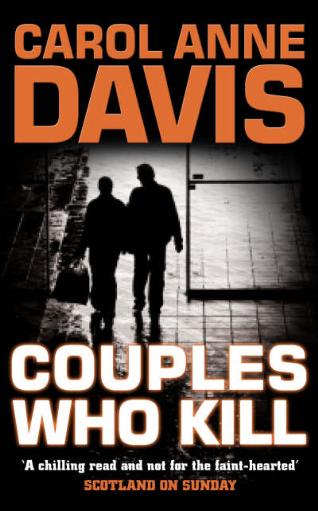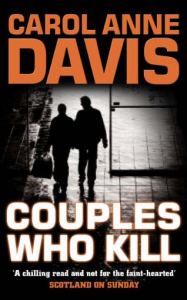



|
|

|

|
|
You are known for both your true crime and your fictional crime books. How does your approach to writing differ in each category?
Writing true crime is even more demanding than writing realistic crime fiction - with non-fiction youíre dealing with real people and events so have to double check everything. Sometimes youíll find that numerous writers have reproduced the same myths: I showed one American article about a British murder case to the detective who had solved it and he said that almost every so-called fact was wrong!
Writing crime fiction is an entirely different process as I think about the characters and plotline for several months whilst Iím writing other things. Gradually the story takes shape until Iím ready to start planning. I then write out several cards for each character, giving their physical description, date of birth, past and current careers, hobbies and so on. Next, I make a chapter by chapter plan - some chapters will have a page of exposition whilst others have only a couple of lines. I hate the planning stage and have to force myself to complete it, but it makes life so much easier when I start to write.
Couples Who Kill is the third in a series of psychological studies. How long did it take from getting the initial idea to the finished product?
I did six months background reading for Couples Who Kill whilst working part-time on other projects. The actual writing of the book took nine months, writing full time.
How do you plan a book such as Couples? First, I decide on a theme which will interest the public but which hasnít been covered recently by other writers - the only other book on couples who kill had been put together by several journalists, each contributing a case study or two. There wasnít a book of profiles by a single author who had researched the subject in depth. Next, I read extensively on the subject so that Iím sure that there are sufficient relevant cases to make up a quality book. Only then will I pitch to a publisher. If they turn it down and suggest a different book, I have to start over again and find another publishing house - by the time I pitch for a commission I know that this will make a saleable and fascinating book and I wonít be sidetracked. Iíve seen so many authors put a good book aside and write a different one at an editorís suggestion, only for that book to fail abysmally. By then, the editor has often moved on to another publishing house and no one remembers their part in the fiasco. The publishing world just thinks that the author, in isolation, has written a bad book.
Later in the writing process I contact various authority figures - for example, for Couples Who Kill I travelled to the Forest Of Dean and interviewed one of Rose and Fred Westís surviving victims. I also contacted David Mulcahy who started a life sentence in 2001 after his estranged friend John Duffy said that heíd taken part in Duffyís 1980ís serial killing spree. Itís a fascinating case, as DNA links Mulcahy to one of the coupleís many rapes but thereís only Duffyís belated confession to link him to the murders. And the police officers who investigated the early rapes were convinced that Mulcahy was a rapist but not a murderer.
How do you feel the media cover crime?
The broadsheets tend to cover crime responsibly, but the tabloids are enormously variable. For example, theyíll sometimes suggest that battered children who kill are `demon seeds.í They can be equally misguided about the backgrounds of adult serial killers - newspapers which covered the Hall-Kitto murders said that Thompson Hall was from a good family, but when I researched him for Couples Who Kill I found that his mother had a terrible temper. Rather than being the law abiding woman that the newspapers described, she had a record for handling stolen goods. The fights in her household were legendary and both of her sons, fathered by different men, ended up in jail.
What do you consider is the most difficult aspect of writing these books?
The sheer amount of work required to produce profiles is daunting. Itís why most writers only offer non-chronological case studies. By jumping about endlessly from one decade to the next, they can easily hide the gaps in their knowledge base.
Have you ever been affected by something youíve discovered?
I had nightmares whilst researching my first true crime book, Women Who Kill, and always feel slightly down after finishing a book of profiles because Iíve uncovered so much dysfunctionality. But, on the upside, I get to speak to some really great individuals such as detectives whoíve worked tirelessly for justice and abuse survivors whoíre now fighting for human rights.
Of what does your writing day consist?
I donít have a set routine, but tend to work for a couple of hours then have a snack or a meal. After that Iíll put in another couple of hours then do an exercise class or walk to the post office or library. At night I usually do reading for future true crime books. For light relief I go to see comedians, everyone from late greats like Bill Hicks and Dave Allen to contemporary comics such as Bill Bailey and Dara OíBriain.
Have you always wanted to be a writer? How would you advise aspiring writers?
No, I originally wanted to be a naturalist and learned everything in my animal books off by heart. Then, at age eight or so, a neighbour asked me what I wanted to be when I grew up and I told him. My father overheard and said `Who are you kidding? You have to be bright and leave home to be a naturalist. People like us donít become things like that.í Afterwards I started telling everyone that I was going to work in the bakery shop down the road and they all seemed really pleased. Ironically, I went on to work in the post office next door to that very bakery for a year. I was in my thirties before my first novel was accepted, though Iíd had lots of short stories and features published by then. Iíd advise aspiring writers to be flexible - if the fiction market isnít commissioning much, try non-fiction. If the book trade is sluggish, try your hand at articles. The more versatile that you are, the more chance you have of surviving in a competitive marketplace.
What do you read and what are you reading now?
I mainly read true crime as I have to do so much research for my books - fortunately itís one of my favourite subjects! Itís fascinating to watch a personís fast or slow descent into criminality. The media gives the impression that people suddenly snap and kill - but in reality they are far more likely to slide into depravity. They may start with Peeping Tom activity, become excited at what they see and graduate to burglaries where they steal womenís underwear. Theyíll fantasise for many months about what theyíd like to do to the owner of such underwear - and, one day, theyíll remain in her apartment and rape her. After a few rapes some gravitate to murder and perhaps kill serially.
Iím currently reading Abused Men by Philip W Cook. There isnít currently enough help for battered women - but thereís even less available for battered men. The general public think such men can just leave the household, but itís complex if sheís abusing the children and heís acting as their protector yet canít gain custody.


Whatís next for Carol Anne Davis? My next novel, Sob Story (Snowbooks Oct 2006), is about Amy, a naÔve teenager who starts writing to a friend-of-a-friend in prison, unaware that heís a psychopathic killer who is due for release and plans to kill again. More information can be found at: |

| Webmaster: Tony 'Grog' Roberts [Contact] |